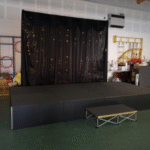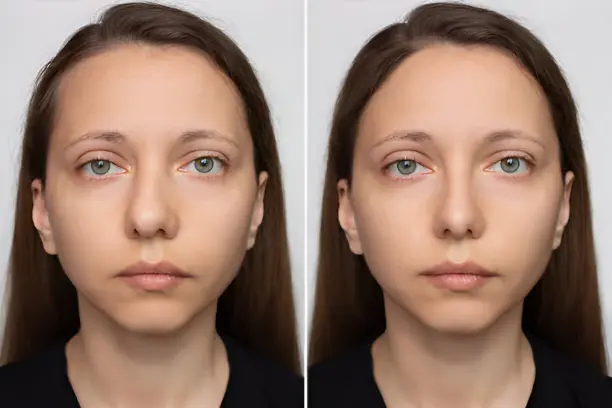Facial asymmetry—commonly called a lopsided face—is far more normal than many realize. While perfect symmetry exists in mathematical equations and artistic renderings, human faces naturally display some degree of asymmetry. However, when this imbalance becomes pronounced or develops suddenly, it may indicate underlying conditions requiring attention. This comprehensive guide explores the causes, treatments, and psychological aspects of facial asymmetry, providing valuable insights for those concerned about their facial balance.
Understanding Facial Asymmetry: More Common Than You Think
Facial asymmetry refers to differences between the left and right sides of the face. These differences may appear in various features:
- Uneven eyebrow height or shape
- One eye appearing larger or positioned differently
- Nasal deviation or asymmetrical nostrils
- Uneven smile or lip fullness
- Jawline or cheek prominence variations
- Uneven hairline or facial hair growth
While celebrities and models often appear perfectly symmetrical in photographs, this typically results from careful positioning, lighting, and digital editing. In reality, even the most celebrated faces display natural asymmetry when examined closely.
Read the full guide: https://dentistdecode.com/lopsided-face/
The Spectrum of Facial Asymmetry

Facial asymmetry exists on a spectrum, ranging from subtle differences noticeable only to the individual to more pronounced variations that others might observe:
Mild Asymmetry
Slight differences that go unnoticed in everyday interactions and are considered within normal variation. Nearly everyone falls into this category.
Moderate Asymmetry
More noticeable differences that don’t significantly impact function but may be apparent in photographs or during close observation.
Pronounced Asymmetry
Significant differences that may affect facial expressions, speech, or eating, potentially indicating an underlying medical condition requiring intervention.
Common Causes of a Lopsided Face
Facial asymmetry stems from various factors, ranging from natural development to medical conditions:
Developmental and Genetic Factors
Natural Development: During fetal development and growth, slight variations in bone and muscle formation naturally occur, creating minor asymmetries.
Genetic Conditions: Certain genetic syndromes like hemifacial microsomia or Goldenhar syndrome can cause more pronounced facial asymmetry from birth.
Habitual Patterns: Consistently sleeping on one side, chewing predominantly with one side, or other repetitive facial movements can gradually create muscle imbalances.
Medical Conditions
Bell’s Palsy: This temporary facial paralysis affects one side of the face, causing drooping and functional limitations. Most cases resolve within months, though some residual asymmetry may persist.
Stroke: Facial drooping on one side is a classic stroke symptom, resulting from nerve damage affecting facial muscle control.
TMJ Disorders: Temporomandibular joint dysfunction can create uneven jaw positioning, affecting overall facial symmetry.
Facial Trauma: Injuries from accidents, sports, or violence can damage facial bones or muscles, leading to asymmetry.
Age-Related Changes
As we age, several factors contribute to increasing facial asymmetry:
- Uneven loss of fat and collagen
- Gravity’s effects on soft tissues
- Bone resorption patterns
- Sun damage differences (often more pronounced on the driver’s side)
- Dental changes affecting jaw alignment
Read the full guide: https://dentistdecode.com/lopsided-face/
When to Seek Medical Attention for Facial Asymmetry
While most facial asymmetry is benign, certain situations warrant prompt medical evaluation:
- Sudden onset of facial drooping or asymmetry
- Asymmetry accompanied by numbness, weakness, or difficulty speaking
- Progressive worsening of asymmetry over a short period
- Facial asymmetry following trauma or injury
- Asymmetry with pain, swelling, or other concerning symptoms
- Functional impairments affecting eating, drinking, or speaking
These symptoms may indicate serious conditions requiring immediate medical intervention, such as stroke, infection, or nerve damage.
Diagnostic Approaches for Facial Asymmetry
When evaluating pronounced facial asymmetry, healthcare providers may employ several diagnostic methods:
Physical Examination: Careful assessment of facial features, muscle strength, and movement patterns.
Imaging Studies: X-rays, CT scans, or MRIs may reveal bone structure abnormalities, tumors, or other structural issues.
Neurological Testing: Evaluating nerve function through electrical stimulation or response testing.
Dental Assessment: Examining bite alignment and jaw function to identify TMJ-related asymmetry.
Photographic Analysis: Standardized photographs may help quantify asymmetry and track changes over time.
Treatment Options for a Lopsided Face
Treatment approaches vary widely depending on the cause, severity, and individual preferences:
Non-Surgical Approaches
Physical Therapy: Facial exercises can strengthen weakened muscles and improve symmetry, particularly beneficial for Bell’s palsy recovery.
Botox Injections: Strategically placed neurotoxin injections can relax overactive muscles on one side or create balance by weakening the stronger side.
Dermal Fillers: Injectable fillers can add volume to areas with deficiency, creating more balanced proportions.
Dental Interventions: Orthodontic treatment, dental restorations, or bite adjustments may improve lower face symmetry.
Facial Prosthetics: Custom-made prosthetics can address significant asymmetry in cases where surgical correction isn’t feasible.
Surgical Options
Facial Reanimation Surgery: For facial paralysis, surgeons may transfer nerves or muscles to restore movement and improve symmetry.
Orthognathic Surgery: Jaw repositioning can correct significant skeletal asymmetries affecting the lower face.
Facial Implants: Custom implants can augment underdeveloped areas of the facial skeleton.
Reconstructive Procedures: Following trauma or tumor removal, reconstructive techniques rebuild facial structures.
Facelift with Asymmetry Correction: Modified facelift techniques can address age-related asymmetry by tailoring the approach to each side’s needs.
Living Confidently with Facial Asymmetry
Beyond medical interventions, several strategies can help individuals embrace their unique facial characteristics:
Psychological Perspectives
Research consistently shows that we perceive our own asymmetries as more noticeable and significant than others do. This “spotlight effect” often leads to unnecessary self-consciousness about facial features that others barely notice.
Understanding that perfect symmetry is neither natural nor necessary for attractiveness can be liberating. Many studies indicate that slight asymmetry is actually perceived as more attractive and authentic than perfect symmetry, which can appear artificial.
Practical Strategies for Everyday Confidence
Hairstyling Techniques: Strategic haircuts and styling can balance facial proportions and draw attention to your best features.
Makeup Approaches: Makeup artists specialize in techniques that create the illusion of greater symmetry through strategic highlighting, contouring, and feature enhancement.
Photography Tips: Understanding your more photogenic angle and positioning accordingly can help you feel more confident in photographs.
Fashion Choices: Necklines, collars, and accessories can draw attention toward or away from specific facial areas.
Posture Improvement: Better alignment of the spine and neck naturally enhances facial positioning and overall appearance.
Children and Facial Asymmetry: Special Considerations
Facial asymmetry in children requires particular attention, as early intervention can sometimes prevent progression:
Monitoring Development: Pediatricians should evaluate significant asymmetry, especially if it appears to worsen during growth.
Helmet Therapy: For infants with positional plagiocephaly (flattening of one side of the head), specialized helmets can guide proper skull development.
Early Orthodontic Intervention: Addressing dental and jaw asymmetries during growth may prevent more severe asymmetry in adulthood.
Psychological Support: Children with noticeable facial differences may benefit from age-appropriate counseling to develop healthy self-image and coping strategies.
The Future of Facial Asymmetry Treatment
Emerging technologies continue to advance treatment options:
3D Printing: Custom implants and surgical guides created through 3D printing allow for unprecedented precision in correcting asymmetry.
Virtual Surgical Planning: Computer modeling enables surgeons to visualize outcomes before performing procedures.
Regenerative Medicine: Stem cell therapies show promise for rebuilding facial tissues affected by trauma or disease.
AI-Assisted Analysis: Artificial intelligence algorithms can quantify subtle asymmetries and suggest optimal correction strategies.
Embracing Your Unique Face
Perhaps the most important aspect of addressing facial asymmetry is recognizing that perfect symmetry is neither natural nor necessary for beauty or function. Throughout history and across cultures, distinctive facial features—including asymmetries—have been celebrated as marks of character and uniqueness.
Many iconic celebrities and public figures display noticeable facial asymmetry, yet their distinctive appearances contribute to their memorability and appeal. From actors to musicians to world leaders, those who embrace their unique facial characteristics often develop a stronger personal brand and presence.
Conclusion
A lopsided face—whether subtle or pronounced—is part of what makes each person unique. While significant asymmetry may sometimes indicate underlying conditions requiring medical attention, most facial asymmetry falls within the beautiful spectrum of human variation.
For those concerned about facial asymmetry, modern medicine offers numerous options ranging from non-invasive techniques to advanced surgical procedures. However, equally important is developing a healthy perspective that recognizes the arbitrary nature of perfect symmetry as a beauty standard.
By understanding the causes and treatment options for facial asymmetry while embracing the uniqueness of your appearance, you can navigate concerns about a lopsided face with knowledge, confidence, and self-acceptance. Remember that the most memorable faces throughout history have rarely been the most symmetrical—they’ve been the most expressive, authentic, and distinctive.

















+ There are no comments
Add yours